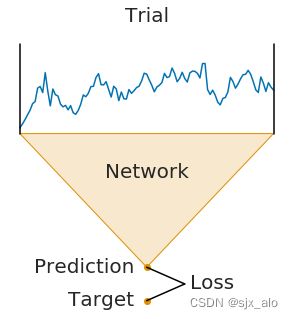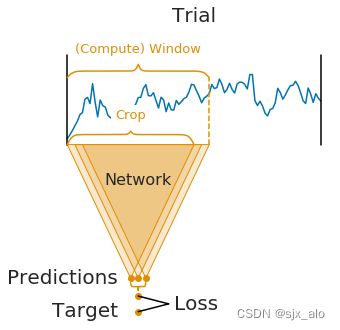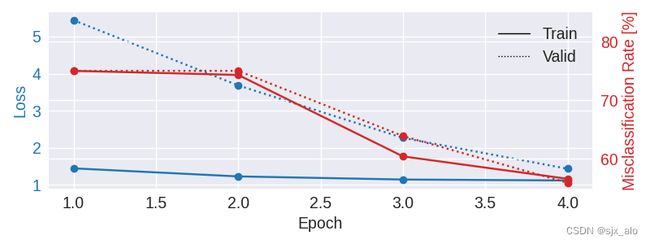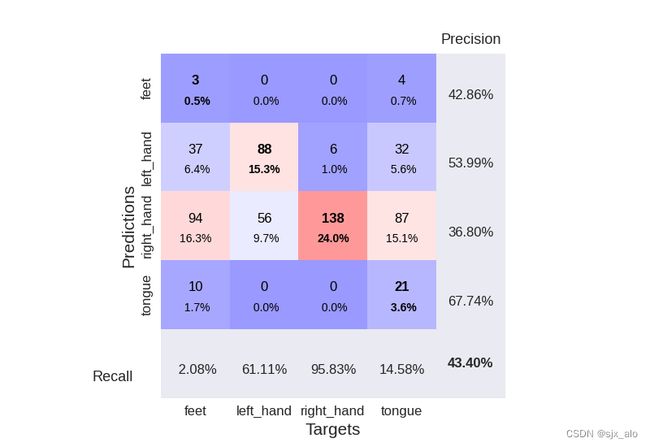Braindecode系列 (2):BCIC IV 2a 数据集上的裁剪解码
Braindecode系列:BCIC IV 2a 数据集上的裁剪解码
- 0. 引言
- 1. decoding 对比
-
- 1.1 trialwise decoding
- 1.2 cropped decoding
- 1.3 两种decoding对比
- 2. Python实现
-
- 2.1 加载和预处理数据集
- 2.2 创建模型并计算窗口参数
- 2.3 将数据剪切到窗口中
- 2.4 切分数据并训练
- 2.5 结果输出图像
- 3. 结果展示
- 4. 总结
0. 引言
在Braindecode系列中,我会介绍跟BCI IV 2a有关的所有相关示例。
在Braindecode中,为训练模型创建了两种受支持的配置: trialwise decoding 和 cropped decoding。其中,trialwise decoding 已经在前面一个部分介绍了在BCIC IV 2a数据集上操作的内容,在本节中,我会接着上面的介绍第二部分的内容:BCIC IV 2a 数据集上的 cropped decoding 被用来进行更高效的数据裁剪解码。
注意:配置环境部分内容参考该系列的上一篇文章!!!
1. decoding 对比
为了更好地说明trialwise decoding 和 cropped decoding的区别,我们将通过比较来直观地解释这一点。
1.1 trialwise decoding
- 一个完整的
Trail通过网络进行。 - 网络产生预测。
- 将该预测与该试验的目标(标签)进行比较,以计算损失。
1.2 cropped decoding
- 作物不是一个完整的
Trial,而是crops通过网络。 - 为了计算效率,同时将多个相邻
crops输入网络(这些相邻crops被称为计算窗口) - 因此,网络产生多个预测(窗口中的每个
crop一个) - 在计算损失函数之前,对单个
crop预测进行平均
1.3 两种decoding对比
- 网络架构隐含地定义了
crop大小(它是感受野大小,即网络用于进行单个预测的时间步长) - 窗口大小是一个用户定义的超参数,在
Braindecode中称为“input_window_samples”。它主要影响运行时(窗口大小越大应该越快)。根据经验,您可以将其设置为crop大小的两倍。 - 裁剪大小和窗口大小一起定义了网络每个窗口进行的预测数量:
window−Crop+1=predictions - 对于
cropped decoding,上述训练设置在数学上与对数据集中的Trial进行采样相同,通过网络推动它们,并直接在单个crop上进行训练。同时,上述训练设置要快得多,因为它通过使用扩张卷积避免了冗余计算。然而,只有在以下情况下,这两种设置在数学上是相同的:(1)你的网络不使用任何填充或只使用左填充(2)当使用平均输出时,你的损失函数导致相同的梯度。第一种适用于我们的浅层和深层ConvNet模型,第二种适用于PyTorch中通常用于分类的对数softmax输出和负对数似然损失。
2. Python实现
2.1 加载和预处理数据集
这部分内容同 trialwise decoding一致。具体代码如下:
from braindecode.datasets import MOABBDataset
subject_id = 3
dataset = MOABBDataset(dataset_name="BNCI2014001", subject_ids=[subject_id])
from braindecode.preprocessing import (
exponential_moving_standardize, preprocess, Preprocessor)
from numpy import multiply
low_cut_hz = 4. # low cut frequency for filtering
high_cut_hz = 38. # high cut frequency for filtering
# Parameters for exponential moving standardization
factor_new = 1e-3
init_block_size = 1000
# Factor to convert from V to uV
factor = 1e6
preprocessors = [
Preprocessor('pick_types', eeg=True, meg=False, stim=False), # Keep EEG sensors
Preprocessor(lambda data: multiply(data, factor)), # Convert from V to uV
Preprocessor('filter', l_freq=low_cut_hz, h_freq=high_cut_hz), # Bandpass filter
Preprocessor(exponential_moving_standardize, # Exponential moving standardization
factor_new=factor_new, init_block_size=init_block_size)
]
# Transform the data
preprocess(dataset, preprocessors)
2.2 创建模型并计算窗口参数
与trialwise decoding相反,我们首先必须创建模型,然后才能将数据集剪切到窗口中。这是因为我们需要知道网络的感受野,才能知道窗口步长应该有多大。
我们首先选择将在训练期间提供给网络的计算/输入窗口大小。这必须大于网络感受野大小,否则可以选择计算效率(请参阅本教程开头的解释)。在这里,我们选择1000个样本,对于250 Hz的采样率,这是4秒。具体代码如下:
input_window_samples = 1000
随后,我们创建模型。为了使其能够有效地用于裁剪解码,我们手动将最终卷积层的长度设置为某个长度,使ConvNet的感受野小于input_window_samples(请参见模型定义中的final_conv_length=30)。具体代码如下:
import torch
from braindecode.util import set_random_seeds
from braindecode.models import ShallowFBCSPNet
cuda = torch.cuda.is_available() # check if GPU is available, if True chooses to use it
device = 'cuda' if cuda else 'cpu'
if cuda:
torch.backends.cudnn.benchmark = True
# Set random seed to be able to roughly reproduce results
# Note that with cudnn benchmark set to True, GPU indeterminism
# may still make results substantially different between runs.
# To obtain more consistent results at the cost of increased computation time,
# you can set `cudnn_benchmark=False` in `set_random_seeds`
# or remove `torch.backends.cudnn.benchmark = True`
seed = 20200220
set_random_seeds(seed=seed, cuda=cuda)
n_classes = 4
# Extract number of chans from dataset
n_chans = dataset[0][0].shape[0]
model = ShallowFBCSPNet(
n_chans,
n_classes,
input_window_samples=input_window_samples,
final_conv_length=30,
)
# Send model to GPU
if cuda:
model.cuda()
随后,我们逐步将模型转换为输出密集预测的模型,这样我们就可以使用它来获得所有crops的预测。具体代码如下:
from braindecode.models import to_dense_prediction_model, get_output_shape
to_dense_prediction_model(model)
其中,为了了解模型的感受野,我们计算了虚拟输入的模型输出的形状。具体代码如下:
n_preds_per_input = get_output_shape(model, n_chans, input_window_samples)[2]
2.3 将数据剪切到窗口中
与trialwise decoding相反,我们必须为create_windows_from_events函数提供明确的窗口大小和窗口步长。具体代码如下:
from braindecode.preprocessing import create_windows_from_events
trial_start_offset_seconds = -0.5
# Extract sampling frequency, check that they are same in all datasets
sfreq = dataset.datasets[0].raw.info['sfreq']
assert all([ds.raw.info['sfreq'] == sfreq for ds in dataset.datasets])
# Calculate the trial start offset in samples.
trial_start_offset_samples = int(trial_start_offset_seconds * sfreq)
# Create windows using braindecode function for this. It needs parameters to define how
# trials should be used.
windows_dataset = create_windows_from_events(
dataset,
trial_start_offset_samples=trial_start_offset_samples,
trial_stop_offset_samples=0,
window_size_samples=input_window_samples,
window_stride_samples=n_preds_per_input,
drop_last_window=False,
preload=True
)
2.4 切分数据并训练
切分数据代码同trialwise decoding,具体代码如下:
splitted = windows_dataset.split('session')
train_set = splitted['session_T']
valid_set = splitted['session_E']
在训练时,与trialwise decoding不同的是,我们现在应该向EEGClassifier提供cropped=True,并将CroppedLoss作为标准,以及criterion_loss_function作为应用于平均预测的损失函数。具体代码如下:
from skorch.callbacks import LRScheduler
from skorch.helper import predefined_split
from braindecode import EEGClassifier
from braindecode.training import CroppedLoss
# These values we found good for shallow network:
lr = 0.0625 * 0.01
weight_decay = 0
# For deep4 they should be:
# lr = 1 * 0.01
# weight_decay = 0.5 * 0.001
batch_size = 64
n_epochs = 4
clf = EEGClassifier(
model,
cropped=True,
criterion=CroppedLoss,
criterion__loss_function=torch.nn.functional.nll_loss,
optimizer=torch.optim.AdamW,
train_split=predefined_split(valid_set),
optimizer__lr=lr,
optimizer__weight_decay=weight_decay,
iterator_train__shuffle=True,
batch_size=batch_size,
callbacks=[
"accuracy", ("lr_scheduler", LRScheduler('CosineAnnealingLR', T_max=n_epochs - 1)),
],
device=device,
)
# Model training for a specified number of epochs. `y` is None as it is already supplied
# in the dataset.
clf.fit(train_set, y=None, epochs=n_epochs)
2.5 结果输出图像
最后,我们使用Skorch在整个训练过程中存储的历史来绘制精度和损失曲线。具体代码如下:
import matplotlib.pyplot as plt
from matplotlib.lines import Line2D
import pandas as pd
# Extract loss and accuracy values for plotting from history object
results_columns = ['train_loss', 'valid_loss', 'train_accuracy', 'valid_accuracy']
df = pd.DataFrame(clf.history[:, results_columns], columns=results_columns,
index=clf.history[:, 'epoch'])
# get percent of misclass for better visual comparison to loss
df = df.assign(train_misclass=100 - 100 * df.train_accuracy,
valid_misclass=100 - 100 * df.valid_accuracy)
plt.style.use('seaborn')
fig, ax1 = plt.subplots(figsize=(8, 3))
df.loc[:, ['train_loss', 'valid_loss']].plot(
ax=ax1, style=['-', ':'], marker='o', color='tab:blue', legend=False, fontsize=14)
ax1.tick_params(axis='y', labelcolor='tab:blue', labelsize=14)
ax1.set_ylabel("Loss", color='tab:blue', fontsize=14)
ax2 = ax1.twinx() # instantiate a second axes that shares the same x-axis
df.loc[:, ['train_misclass', 'valid_misclass']].plot(
ax=ax2, style=['-', ':'], marker='o', color='tab:red', legend=False)
ax2.tick_params(axis='y', labelcolor='tab:red', labelsize=14)
ax2.set_ylabel("Misclassification Rate [%]", color='tab:red', fontsize=14)
ax2.set_ylim(ax2.get_ylim()[0], 85) # make some room for legend
ax1.set_xlabel("Epoch", fontsize=14)
# where some data has already been plotted to ax
handles = []
handles.append(Line2D([0], [0], color='black', linewidth=1, linestyle='-', label='Train'))
handles.append(Line2D([0], [0], color='black', linewidth=1, linestyle=':', label='Valid'))
plt.legend(handles, [h.get_label() for h in handles], fontsize=14)
plt.tight_layout()
为了更好地展现结果,这里给出了绘制混淆矩阵的代码:
from sklearn.metrics import confusion_matrix
from braindecode.visualization import plot_confusion_matrix
# generate confusion matrices
# get the targets
y_true = valid_set.get_metadata().target
y_pred = clf.predict(valid_set)
# generating confusion matrix
confusion_mat = confusion_matrix(y_true, y_pred)
# add class labels
# label_dict is class_name : str -> i_class : int
label_dict = valid_set.datasets[0].windows.event_id.items()
# sort the labels by values (values are integer class labels)
labels = list(dict(sorted(list(label_dict), key=lambda kv: kv[1])).keys())
# plot the basic conf. matrix
plot_confusion_matrix(confusion_mat, class_names=labels)
3. 结果展示
4. 总结
到此,使用 Braindecode系列(2):BCIC IV 2a 数据集上的裁剪解码 已经介绍完毕了!!! 如果有什么疑问欢迎在评论区提出,对于共性问题可能会后续添加到文章介绍中。
如果觉得这篇文章对你有用,记得点赞、收藏并分享给你的小伙伴们哦。



